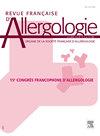Depemokimab efficacy/safety in patients with asthma on medium/high-dose ICS: The Phase IIIA randomised SWIFT-1/2 studies
IF 0.3
4区 医学
引用次数: 0
Abstract
Prérequis/contexte
Depemokimab is the first ultra-long-acting biologic to have enhanced binding affinity for interleukin-5 (IL-5) with high potency inhibition, enabling six-month dosing intervals for patients with asthma.
Objectifs
The primary end point was the annualized rate of exacerbations at 52 weeks. Secondary end points, which were analyzed in a hierarchical manner to adjust for multiplicity, included the change from baseline in the score on the St. George's Respiratory Questionnaire (SGRQ), the forced expiratory volume in 1 second, and asthma symptom reports at 52 weeks.
Méthodes
In these phase 3A, randomized, placebo-controlled replicate trials, we evaluated the efficacy and safety of depemokimab in patients with severe asthma and an eosinophilic phenotype characterized by a high eosinophil count (≥300 cells per microliter in the previous 12 months or ≥150 cells per microliter at screening) and a history of exacerbations despite the receipt of medium- or high-dose inhaled glucocorticoids. Patients were randomly assigned in a 2: 1 ratio to receive either depemokimab (at a dose of 100 mg subcutaneously) or placebo at weeks 0 and 26, plus standard care.
Résultats/discussions
Annualised clinically significant exacerbation rate over 52 weeks in SWIFT-1/2 was significantly lower (58/48%; P < 0.001) for depemokimab vs placebo. Proportions of patients with an adverse event (AE) were similar for depemokimab vs placebo in SWIFT-1 (73%) and lower in SWIFT-2 (72 vs 78%); AEs leading to discontinuation/withdrawal were <3% across groups in both trials. A smaller proportion of depemokimab patients had a serious AE vs placebo (SWIFT-1: 6 vs 17%; SWIFT-2: 7 vs 10%).
Conclusion
Depemokimab significantly reduced exacerbations and was well tolerated in patients with asthma with type 2 inflammation recognised by blood eosinophil count.
deemokimab在哮喘患者中/高剂量ICS中的疗效/安全性:iii期随机SWIFT-1/2研究
depemokimab是首个对白细胞介素-5 (IL-5)具有增强结合亲和力并具有高效抑制作用的超长效生物制剂,哮喘患者可实现6个月的给药间隔。目的:主要终点是52周时的年化恶化率。次要终点以分级方式进行分析以调整多样性,包括圣乔治呼吸问卷(SGRQ)评分与基线的变化,1秒内用力呼气量和52周时哮喘症状报告。在这些3A期随机、安慰剂对照的重复试验中,我们评估了depemokimab在重度哮喘和嗜酸性粒细胞表型患者中的疗效和安全性,这些患者的嗜酸性粒细胞计数高(前12个月≥300个细胞/微升或筛查时≥150个细胞/微升),尽管接受了中剂量或高剂量吸入糖皮质激素,但仍有恶化史。患者以2:1的比例随机分配,在第0周和第26周接受depemokimab(剂量为100mg皮下注射)或安慰剂,外加标准治疗。在SWIFT-1/2组中,52周的年化临床显著加重率显著降低(58/48%;P & lt;deemokimab vs安慰剂的0.001)。在SWIFT-1中,deemokimab与安慰剂的不良事件(AE)患者比例相似(73%),在SWIFT-2中较低(72% vs 78%);两组试验中导致停药/停药的不良事件发生率均为3%。与安慰剂相比,depemokimab患者发生严重AE的比例较小(SWIFT-1: 6% vs 17%;SWIFT-2: 7 vs 10%)。结论deemokimab可显著降低哮喘伴2型炎症患者的急性加重,且耐受性良好。
本文章由计算机程序翻译,如有差异,请以英文原文为准。
求助全文
约1分钟内获得全文
求助全文
来源期刊

Revue Francaise d Allergologie
Medicine-Immunology and Allergy
自引率
33.30%
发文量
349
期刊介绍:
La Revue Française d''Allergologie : un véritable forum pour faire connaître des travaux originaux et permettre la diffusion de l''information auprès de toutes les spécialités concernées par les pathologies allergiques. La Revue Française d''Allergologie (8 numéros par an) est au carrefour de nombreuses spécialités - dermatologie, pédiatrie, ORL, pneumologie, ophtalmologie, médecine interne - qui, toutes, ont à traiter des maladies allergiques. Les symptômes des allergies fondés sur des mécanismes communs sont le plus souvent associés et se succèdent chez un même patient. En forte progression depuis 20 ans, les maladies allergiques sont dans l''attente de perfectionnements et d''avancées thérapeutiques qui permettront aux nombreux patients qui en sont atteints de mieux vivre avec leurs allergies. La Revue Française d''Allergologie se veut donc un véritable forum de discussions et d''échanges entre tous les spécialistes confrontés aux pathologies
 求助内容:
求助内容: 应助结果提醒方式:
应助结果提醒方式:


